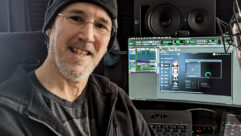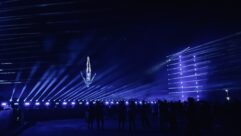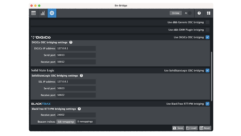
Soundscapes
May 13, 2013 4:05 PM,
By Alan Hardiman
How an exhibit came to life with immersive audio.

“Battle of the Titans,” a dinosaur exhibit staged at the Royal Botanical Gardens in Burlington, Ontario, this past winter featured life-size recreations of a tyrannosaurus rex and triceratops charging toward each other. Behind the scenes the exhibit relied on a TiMax2 Soundhub to create an immersive sonic environment that enveloped visitors in the sounds of the late Cretaceous period, transporting them 70 million years back in time.
Veteran sound designer Gary Hardesty, who created the sound design for the opening and closing ceremonies of the 2008 Beijing Summer Olympics, programmed a 16-channel surround soundscape consisting of more than 300 individual ambiences and effects, all of them true to what is known of the period from the most recent scientific evidence.
The soundscape was reproduced via 36 powered Electro-Voice loudspeakers arrayed around the two-story high atrium of the Camilla and Peter Dalglish Auditorium, the upper level consisting of a 10ft.-wide balcony on all sides, with a stairway descending to the main floor in the center well.
The 4,000-square-foot interactive experience ran from Jan. 26 to April 7 and featured real fossils, stunning graphics, exciting videos, living dioramas, interactive displays, immersive background audio, live plants, and of course, life-size dinosaurs created by Universal Studios’ Jurassic Park theme park designer Hall Train, in association with renowned paleontologist Dr. Phil Manning and his scientific team. “Battle of the Titans” featured 11 kiosks fitted with 26in. Samsung flatpanel displays distributed around the lower floor and balcony. Together they ran more than 90 minutes of video streamed from 8GB USB drives, consisting of interviews, dinosaur animation, computer graphics, and specially filmed wildlife sequences of lions, rhinos, and other exotic species that compare lifestyles of extinct and living animals.

“Given that there are some 300 botanical gardens in North America, many of which are dark in the January-April period when plants are dormant, it’s not surprising that operators are actively on the lookout for exhibits such as this to attract visitors,” says Michael Lofranco, the exhibit’s marketing director. “The tie-in of a dinosaur show with a botanical garden is a natural one, since most, if not all, of the plants from that period are still living all around us, so the flora are familiar, even if the fauna are extinct.”
Hardesty’s mandate was to create that environment. “I chose to build a 3D soundscape that would tell a bit of a story, starting with a Tibetan flute and a low-frequency drone to create a feeling of mystery, and progressing to building the forest, injecting different birds from that era, along with frogs, crickets, and a lot of things that were alive back then to tell the story of the forest evolving, then becoming a bit turbulent and stormy with wind and thunder, before looping back to the flute after about 72 minutes,” he says.
“If you’re on the lower floor, you can hear the water flowing from the dig area known as Hell Creek. The soundscape is so immersive, the forest so deep, that when you turn it off, it feels like the whole room just collapses. That’s when you realize how much TiMax is contributing to that whole environment. It’s very cool,” Hardesty says.
“[After] doing a lot of research and talking to colleagues and friends, I elected to go with the TiMax2 Soundhub, and it proved to be very comprehensive in terms of what I was able to do, and I was very, very excited to use it,” he says.
The Soundhub is expandable in increments of 16 I/O up to 64×64 in a 2RU package. Its unique input-output matrix provides up to 4,096 crosspoints, each of which affords control of both level and delay for precise localization of sound sources through manipulation of Haas-effect binaural perceptual cues.
Hardesty and sound system provider Scott Pollard of Palmer Audio elected to keep it simple. With the Soundhub’s I/O matrix and onboard 8-band parametric EQ rendering a console superfluous, they routed 10 of the Soundhub’s 16 outputs directly to 10 of the loudspeakers on a one-to-one basis. The remaining six outputs were daisy-chained in groups through the remaining 26 cabinets to allow some spreading of the ambient effects. The loudspeaker system was comprised of 21 EV ZXA1 and 15 EV ELX112P two-way self-powered cabinets.
Soundscapes
May 13, 2013 4:05 PM,
By Alan Hardiman
How an exhibit came to life with immersive audio.

“The learning curve on the TiMax was actually pretty darned simple,” Hardesty noted. “It’s very intuitive, very simple to use, and very friendly. I liked that the timeline editor is almost Cubase-like or ProTools-like in terms of dragging and dropping sounds on tracks and being able to do a lot of editing of your tracks right in the TiMax domain, so you don’t have to worry about bringing fully finished pieces into it.
“And being able to layer cues was great. In my case, due to the budget, I was limited to 16 outputs, although I could have used 32. So what I did was, on a given track, I put in a number of different cues in which I changed the routing of the sound completely. Having the ability to assign routing multiple times certainly gives you a lot of flexibility. I think those two features combined are very powerful. Plus the fact that you can do a ton of EQ on the input and the output, and mix multiple input sources on any input channel is very flexible,” he says.
In the event of a power failure in the facility, Hardesty programmed the Soundhub to restart at the beginning of the loop on power-up. “I told them just to leave everything running, and if power should ever fail to the server, the TiMax will just reboot and start at the top of the show, and they never need to worry about it.”

“It’s just been going and running perfectly,” Pollard confirmed, adding, “We looked at LCS and some of the other equipment that’s available, and we found TiMax to be the most cost effective and most fully featured. The cost is about the same as you would pay just for loudspeaker DSP, so all the playback, input-output matrixing, and show control is basically free.”
As for the Soundhub’s show control capability, Hardesty says, “I’m working on that right now. As soon as we get this show to another venue, I believe they’ll have the additional budget to do more, and at that point I’ll certainly be injecting more effects and more controls for triggering cues.”
Train confirmed that he has constructed loudspeaker mounts in the back of the dinosaurs’ mouths. For the next iteration of the show, it’s just a matter of programming the Soundhub to react to the presence of an unsuspecting visitor via motion sensors in order to take the show’s interactivity to the next engaging—and perhaps not just a little frightening—level.
“Having done sound design for many large events over the years, it was certainly a pleasure to be included in this project,” Hardesty concludes. “I will continue to use TiMax in all my designs, and there are some very high profile productions coming up in the next couple of years that will involve myself—and TiMax.”
Veteran sound designer Alan Hardiman is president of Sound Design Devices, providing technology and design services to the exhibit industry. He recently employed the TiMax Soundhub on the four-day immersive theater production, The Wharf at York, staged at Toronto’s Harbour Square Park.










